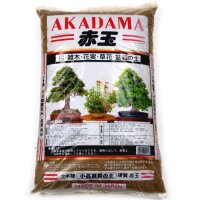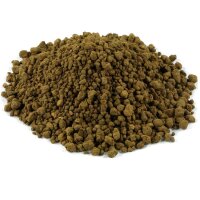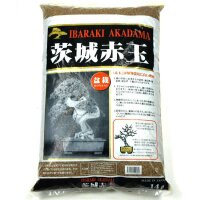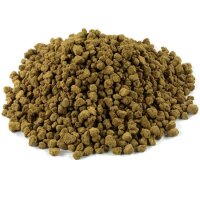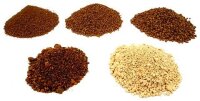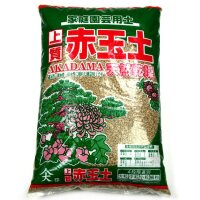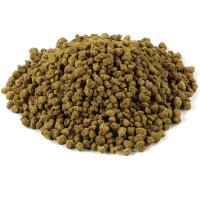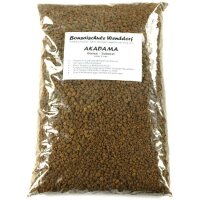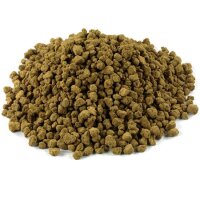Akadama
Bonsai soil Kanuma Kiryu Bonsai substrates Pumice gravel
The Akadama bonsai soil is irreplaceable in bonsai care for repotting. Akadama is a clay granulate with a reddish brown colour (Akadama-Tsuchi, japanese 赤玉土 = red earth) of volcanic origin and occurs in Japan on the island of Honshu. It is mined in open-cast mines and exported all over the world.
We buy Akadama, mostly the Ibaraki brand, cheaply in different qualities and packages directly in Japan. We are happy to pass this price advantage on to you. Irrespective of the favourable price, Akadama is highly recommended as a substrate. It's got everything a good bonsai soil needs.
What are the advantages of Akadama bonsai soil ?
- Akadama offers a good stability for your bonsai after repotting
- Root cells need oxygen. The good permeability of the Akadama bonsai soil brings air into the ground
- Little tendency to soil compaction. Akadama remains structurally stable, even over long periods of time until the next repotting
- The excellent drainage properties of this bonsai soil are good against root rot
- Akadama has a high ability to retain nutrients in the bonsai soil once they have been ingested
- The buffer capacity of Akadama works against pH fluctuations and soil acidification
Which qualities of the Akadama bonsai soil are there ?
Akadama is dimensionally stable, hardly compacts and decomposes only slowly. Nevertheless, Akadama slowly loses its coarseness, the air permeability decreases and the salt content increases. Thus the essential advantages are lost - an exchange (repotting of the bonsai) becomes necessary.
Depending on the quality of the Akadama bonsai soil (soft and hard) it should be replaced after 3-5 years.
- Akadama soft quality, Single line brand: Japanese 上質, Jōshitsu. Structural stability for up to 3 years. Can be used for bonsai trees that are frequently repotted (deciduous trees with strong root growth like Fig tree bonsai, Chinese elm bonsai, Japanese maple bonsai, but also other plants such as flowers).
- Akadama hard quality, Double line brand: Japanese 硬質, Kōshitsu. Is structurally stable for longer time (4-5 years). Akadama hard quality should be taken if the bonsai remains longer than 3 years without repotting in the bonsai pots. This is especially true for older bonsai.
- Akadama extra hard quality, Triple line Brand: Japanese 赤玉土. The Akadama brand with the 3 lines is broken down from slightly deeper layers, heated at 250-300°C after processing and is therefore the longest structurally stable kind of Akadama.
Soil mixtures
Akadama is mostly used purely, i.e. to 100%. Sometimes, however, it is also added more or less strongly as a component of an bonsai soil mixture. This depends essentially on the tree species and the age of your bonsai. By combining the advantages of clay with very good water permeability, it is possible to reduce the proportion of sand and gravel in an bonsai earth mixture.
If a slightly acidic pH value is required (e. g. for buffering when using harder pouring water), a little bit peat (30%) can be added.
It is difficult to give a general recipe for the use of Akadama in bonsai soil mixtures. In general it can be said that older plants have a higher proportion of Akadama than young plants.
Some bonsai species seem to tolerate pure Akadama not so good (e.g. Larch bonsai).
Bonsai friends sometimes use Akadama for soil mixtures. We recommend the use of Akadama pure. This bonsai soil has everything a bonsai substrate needs. Mixing them does not bring any significant advantages. Important: Akadama is delivered dry. Pour the bonsai well immediately after potting.
Grain sizes
Akadama is available in various grain sizes (fine 1-5mm, medium 5-10mm and coarse >10mm) from specialist bonsai retailers.
The coarse-grained mixtures are used to improve drainage in the lower part of the bonsai substrate, the fine-grained mixtures as top layer. Many bonsai friends seven Akadama before use to remove the fine ingredients (dust) and further increase water and air permeability.
Watering
Akadama can store water, but due to its good water permeability it can be watered more often than usual, depending on the proportion of Akadama in the bonsai soil. If it is used pure, this can mean that in summer it has to be poured more than once a day.
In Japan, where many bonsai are hold in pure Akadama, watering is much more frequent than in Europe. However, with this substrate overpouring and the resulting waterlogging is almost impossible.
Depending on water absorption, the colour changes from a light reddish brown (dry) to almost brown (moist). This colour change makes it easy to see when it is time to water a bonsai tree.
Important: Since Akadama is delivered dry, it is important to water well immediately after potting. Otherwise root damage may occur.
Fertilization
The higher the proportion of Akadama in the soil mixture (similar to other mineral substrates - e.g. expanded shale), the more attention must be paid to bonsai fertilisation.
Mineral fertilizers dissolved in water are quickly washed out and are therefore no longer available to the plant. If mineral fertilizers are to be used, a small dosage is recommended combined with frequent applications.
The use of organic bonsai fertilizers (for example Biogold, Hanagokoro or liquid bonsai fertilizer) has proved its worth well. Due to the slow release process of nutrients, bonsai are adequately and above all evenly supplied over a long period of time. There is hardly any overfertilisation or salinisation of the bonsai soil.
pH of Akadama
pH value of Akadama is 6.5-6.9, ie. slightly acidic. Due to the high buffer capacity of this bonsai soil, the pH value hardly rises.

